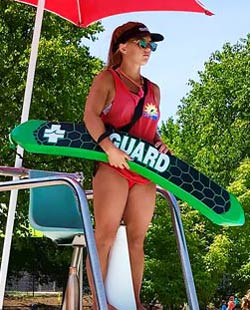
Don’t Sing the Blues This Summer!
 Summertime, the busiest season for PDRMA members, is rightly celebrated in pop culture and has inspired many songs. But two summer occurrences — heat-related illnesses and poison ivy — might tempt you to sing the blues! Summertime, the busiest season for PDRMA members, is rightly celebrated in pop culture and has inspired many songs. But two summer occurrences — heat-related illnesses and poison ivy — might tempt you to sing the blues!
 Poison Ivy Poison Ivy
If you’ve had the unpleasant experience of reacting to poison ivy (or its cousins), we don’t need to tell you it can definitely tempt you into singing the blues! Anyone working in — or enjoying — the outdoors is at risk of exposure to poisonous plants like poison ivy, poison oak and poison sumac.
It’s the sap oil of these plants that causes an allergic reaction when it touches your skin. And the sap is in the roots, stems, leaves and fruits. When you bruise the plant by stepping on it, breaking a stem or pulling off a leaf, you release that sap. Keep in mind that if you feed tree branches with the poisonous plants attached into a chipper, the sap can become airborne and cause allergic reactions without people having direct contact with the plants. In addition, burning these plants produces smoke that can cause lung irritation when inhaled.
Exposure to any form of the sap can result in:
- Red rash within a few days of contact that can take up to 10 days to heal.
- Swelling.
- Itching.
- Possible bumps, patches, streaking or weeping blisters. NOTE: Blister fluids do not spread the sap.
- Severe allergic reactions — such as swelling or difficulty breathing — for which you should call 911.
To limit or prevent exposure:
- Wear long-sleeved shirts and long pants, tucked into boots. Wear cloth or leather gloves.
- Apply barrier creams to exposed skin.
- Educate employees on how to identify poison ivy, oak and sumac.
- Educate staff about the signs and symptoms of contact with these poisonous plants.
- Keep rubbing alcohol accessible, as it removes the oily resin from sap up to 30 minutes after exposure.
PDRMA Resources
|
The U.S. Department of Labor’s Bureau of Labor Statistics shows that from 2011 to 2019, heat-related episodes averaged 38 fatalities per year and 2,700 cases requiring days away from work. These illnesses range from heat cramps to heat stroke (which can lead to death) and can affect anyone regardless of age or physical condition.
Although the elderly, the very young, those with certain medical conditions or taking certain medications are most at risk, heat stroke can occur in people of any age even without existing health problems or medications. All it takes is working or playing outdoors, engaging in strenuous activity or wearing heavy gear. This is especially true for lifeguards at outdoor pools, where they are outside performing scans.
 |
Lifeguard Fran Graf performs scans
from her lifeguard chair |
For Ben Nelson, Superintendent of Recreation, West Chicago Park District, reducing the risk of heat-related illness — especially for their lifeguards — means starting early. “Prior to the season beginning, as well as throughout it, we discuss with lifeguards and other pool staff the importance of sun protection anytime they are working outdoors,” he explains. “We train all our staff at Turtle Splash in first aid, which includes how to treat heat exhaustion and heat stroke.”
Keep an Eye on the Heat Index
You can find a key tool in preventing heat-related illness on your smart phone, Nelson notes. “We use weather apps on our phones and computers to monitor weather conditions regularly including the heat index,” he explains. [The National Weather Service’s heat index — a combination of heat and humidity — classifies environmental heat into four categories: Caution (80°F - 90°F), Extreme Caution (91°F - 103°F), Danger (103°F - 124°F) and Extreme Danger (126°F or higher)].
“At the hottest time of year for us, our heat index can get to the low 100s,” Nelson points out. “As a management team, we constantly watch the weather conditions and heat index to make adjustments as needed. When the temp gets high, we make adjustments — including shortening rotation times and frequently checking-in with lifeguards on chairs — to make sure our staff is safe. We provide extra water breaks, encourage them to take their breaks in air-conditioned areas of the facility and provide popsicles to help them cool down.
“During our hourly safety breaks,” adds Nelson, “our pool supervisors/assistant supervisors walk from lifeguard chair to lifeguard chair and watch each zone, allowing the lifeguards to jump in the water and cool down, if they want.”
Top tips for handling heat waves
 |
Aquatic mascot Tortuga (l)
and Lifeguard Emma Tate |
What beat-the-heat tips does Nelson have for fellow PDRMA members? “I recommend frequent monitoring as weather can change quickly, and it’s important to stay ahead of it. Have a plan in place for how to adjust your operations when temperatures are high and keep staff safety at the forefront. During a heat wave we had last year, we were extremely busy — as anticipated — but adjusted our operations to shorten rotation times and provide frequent water breaks for our staff.”
PDRMA Resources
|